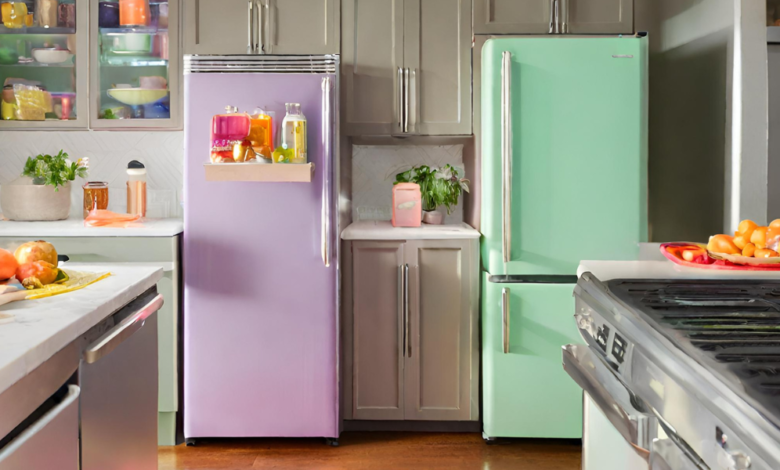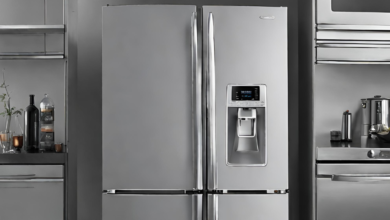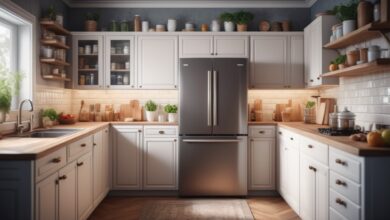Kitchen Space Planning for the Right Refrigerator Size

Kitchen space planning is a meticulous process that involves thoughtful consideration of various elements to create a functional and aesthetically pleasing environment. One of the key appliances that demands careful planning is the refrigerator. In this detailed guide, we will delve into the intricacies of kitchen space planning, focusing specifically on choosing the right refrigerator size. From measuring your kitchen space to understanding the impact of different refrigerator types, we’ll explore every aspect to help you make an informed decision.
The Role of Refrigerators in Kitchen Space
Refrigerators are not just functional appliances; they are central to the flow and organization of your kitchen. The size and placement of your refrigerator can significantly impact the overall design and functionality of the space. Effective kitchen space planning takes into account both the physical dimensions of the refrigerator and its integration with the overall layout.
Measuring Your Kitchen Space
1. Width, Height, and Depth
Begin by measuring the width, height, and depth of the designated space for your refrigerator. Ensure accuracy by measuring multiple times and considering potential obstructions such as countertops, cabinets, and walls. Take note of any architectural features that may affect the placement and accessibility of the refrigerator.
2. Ventilation Clearance
Refrigerators require proper ventilation to function efficiently. Check the manufacturer’s recommendations for ventilation clearance, which is the space needed around the refrigerator for air circulation. This is crucial for preventing overheating and ensuring optimal performance.
3. Door Swing Clearance
Consider the swing of the refrigerator doors. Measure the space required for the doors to open fully without obstruction. This is particularly important for refrigerators with wider doors, such as French door or side-by-side models.
Understanding Kitchen Layouts
Different kitchen layouts demand different approaches to space planning. Whether you have a galley kitchen, U-shaped kitchen, L-shaped kitchen, or an open-concept layout, understanding how your refrigerator fits into the overall design is essential.
1. Galley Kitchens
In galley kitchens with parallel counters, space is often limited. Opt for a refrigerator with a slim profile that can seamlessly integrate into the layout. Consider a top-freezer or bottom-freezer model to maximize vertical space.
2. U-Shaped and L-Shaped Kitchens
These layouts offer more flexibility in terms of refrigerator placement. A standard-depth refrigerator can work well in these kitchens, but be mindful of the traffic flow and ensure that the refrigerator doesn’t disrupt the natural movement within the space.
3. Open-Concept Kitchens
In open-concept kitchens, the refrigerator is often visible from multiple angles. This makes aesthetics as important as functionality. Consider a stylish French door or side-by-side refrigerator that complements the overall design of the living space.
Refrigerator Types and Configurations
Once you have a clear understanding of your kitchen space and layout, it’s time to explore the different types and configurations of refrigerators available in the market.
1. Top-Freezer Refrigerators
Ideal for smaller kitchens, top-freezer refrigerators have a classic design with the freezer compartment at the top. They are space-efficient and budget-friendly, making them suitable for kitchens with limited square footage.
2. Bottom-Freezer Refrigerators
With the freezer compartment at the bottom, these refrigerators offer more convenience for accessing fresh food at eye level. They are a popular choice for those who prefer a modern aesthetic and desire easier access to everyday items.
3. Side-by-Side Refrigerators
Featuring vertical doors that split the refrigerator into two compartments—one for fresh food and the other for the freezer—side-by-side refrigerators are space-saving and provide easy access to both sections. They work well in narrow kitchen spaces.
4. French Door Refrigerators
Known for their elegant design, French door refrigerators have two doors for the fresh food compartment and a bottom freezer drawer. They often come with advanced features and are a stylish choice for spacious kitchens.
5. Counter-Depth Refrigerators
Designed to align with standard kitchen cabinets, counter-depth refrigerators provide a built-in look without protruding into the kitchen space. While aesthetically pleasing, they may have slightly less storage capacity.
Matching Refrigerator Size to Family Needs
The size of your family plays a crucial role in determining the capacity of the refrigerator you need. Consider the following factors to ensure your refrigerator can accommodate your family’s needs.
1. Family Size and Lifestyle
For a family of four, a refrigerator with a capacity of 18 to 20 cubic feet is generally sufficient. However, if you have a large family or frequently entertain guests, opting for a larger capacity is advisable to avoid constant reorganization and overcrowding.
2. Customization Options
Look for refrigerators with adjustable shelves and storage bins. This flexibility allows you to customize the interior space based on your family’s unique needs, accommodating items of varying sizes and shapes.
3. Consider Future Needs
Anticipate any changes in your family size or lifestyle in the coming years. Investing in a slightly larger refrigerator can be a practical decision if you expect your family to grow or if your lifestyle is likely to evolve.
Budget Considerations
While it’s tempting to focus solely on features and aesthetics, aligning your choice with your budget is essential for a satisfying and stress-free experience.
1. Total Cost of Ownership
Consider the total cost of ownership, including upfront cost, energy consumption, and potential maintenance expenses. Investing in a slightly more expensive, energy-efficient model may result in long-term savings.
2. Seasonal Sales and Promotions
Keep an eye out for seasonal sales and promotions
. Major holidays and appliance-focused events often bring discounts and special offers, providing an opportunity to get a premium refrigerator at a more affordable price.
3. Refurbished and Open-Box Options
Explore refurbished or open-box options from reputable retailers. These options can offer significant discounts while still providing reliable performance. Ensure that the warranty and return policy meet your expectations.
Conclusion
Kitchen space planning for the right refrigerator size is a nuanced process that requires a thorough understanding of your kitchen layout, family needs, and personal preferences. By meticulously measuring your kitchen space, considering layout dynamics, and exploring the various types and configurations of refrigerators, you can make an informed decision that enhances both the functionality and visual appeal of your kitchen. Remember to prioritize energy efficiency, explore customization options, and stay within your budget to create a harmonious and efficient kitchen space that caters to your unique lifestyle.






